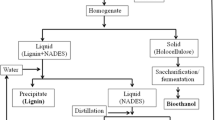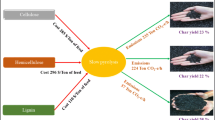Abstract
Autohydrolysis is a hot water pretreatment to extract soluble components from wood that can be used prior to converting the woody residuals into paper, wood products, fuel, or other goods. In this study, mixed softwood chips were autohydrolyzed in hot water at 150, 160, 170, and 180 °C for 1 and 2 h residence times. The objective was to understand the tradeoff between the extraction of fermentable sugar and the residual solid total energy of combustion quantitatively. This process strategy will be referred to as “value prior to combustion”. High-performance liquid chromatography was used to determine chemical compositions (sugars and byproducts such as acetic acid, furfural, and hydroxymethylfurfural) of the extracted liquid and residuals; a bomb calorimeter was used to measure the heating value of original wood and solid residue. As the autohydrolysis temperature increased, material balances of the system indicated higher volatile byproducts loss. More hemicelluloses were solubilized by the hot water extraction process at higher temperatures and longer residence times, and a greater degree of sugar degradation was also observed. The maximum sugar yield was determined to occur at conditions of 170 °C for 2 h, during which 13 g of sugar was recovered from the extract out of 100 g of oven-dried wood. The heating value of the solid residues after extraction was greater than the original wood. The total energy content of the solid residual after extraction ranged from 85 to 98 % of the original energy content of the feed with higher temperatures reducing the total energy content.



Similar content being viewed by others
References
Gonzalez R, Daystar J, Jett M, Treasure T, Jameel H, Venditti R et al (2011) Economics of cellulosic ethanol production in a thermochemical pathway for softwood, hardwood, corn stover and switchgrass. Fuel Process Technol 94:113–122
Stöcker M (2008) Biofuels and biomass-to-liquid fuels in the biorefinery: catalytic conversion of lignocellulosic biomass using porous materials. Angew Chem Int Ed 47:9200–9211
Tunc MS, Lawoko M, van Heiningen A (2010) Understanding the limitations of removal of hemicelluloses during autohydrolysis of a mixture of southern hardwoods. Bioresources 5:356–371
Westbye P, Köhnke T, Gatenholm P (2008) Fractionation and characterization of xylan rich extracts from birch. Holzforschung 62:31–37
Ragauskas A, Williams C, Davison B, Britovsek G, Cairney J, Eckert C et al (2006) The path forward for biofuels and biomaterials. Science 311:484
Willför S, Sundberg A, Hemming J, Holmbom B (2005) Polysaccharides in some industrially important softwood species. Wood Sci Technol 39:245–257
Willför S, Sundberg K, Tenkanen M, Holmbom B (2008) Spruce-derived mannans—a potential raw material for hydrocolloids and novel advanced natural materials. Carbohydr Polym 72:197–210
Amidon T, Wood C, Shupe A, Wang Y, Graves M, Liu S (2008) Biorefinery: conversion of woody biomass to chemicals, energy and materials. J Biobased Mater Bioenergy 2:100–120
Li H, Saeed A, Jahan MS, Ni Y, van Heiningen A (2010) Hemicellulose removal from hardwood chips in the pre-hydrolysis step of the kraft-based dissolving pulp production process. J Wood Chem Technol 30:48–60
Li J, Henriksson G, Gellerstedt G (2005) Carbohydrate reactions during high-temperature steam treatment of aspen wood. Appl Biochem Biotechnol 125:175–188
Salam A, Venditti R, Pawlak J, El-Tahlawy K (2011) Crosslinked hemicellulose citrate-chitosan aerogel foams. Carbohydr Polym 84:1221–1229
Rughani J, McGinnis GD (1989) Combined rapid–steam hydrolysis and organosolv pretreatment of mixed southern hardwoods. Biotechnol Bioeng 33:681–686
Leschinsky M, Sixta H, Patt R (2009) Detailed mass balances of the autohydrolysis of Eucalyptus globulus at 170 °C. Bioresources 4:687–703
Taherzadeh M, Karimi K (2008) Pretreatment of lignocellulosic wastes to improve ethanol and biogas production: a review. Int J Mol Sci 9:1621–1651
Hess J, Wright C, Kenney K (2007) Cellulosic biomass feedstocks and logistics for ethanol production. Biofuels, Bioprod Biorefin 1:181–190
Stoutenburg R, Perrotta J, Amidon T, Nakas J (2008) Ethanol production from a membrane purified hemicellulosic hydrolysate derived from sugar maple by Pichia stipitis NRRL Y-7124. Bioresources 3:1349–1358
Liu S, Amidon T, Francis R, Ramarao B, Lai Y, Scott G (2006) From forest biomass to chemicals and energy… Biorefinery initiative in New York State. Ind Biotechnol 2:113–120
Lundqvist J, Jacobs A, Palm M, Zacchi G, Dahlman O, Stalbrand H (2003) Characterization of galactoglucomannan extracted from spruce (Picea abies) by heat-fractionation at different conditions. Carbohydr Polym 51:203–211
Amidon T, Liu S (2009) Water-based woody biorefinery. Biotechnol Adv 27:542–550
Caparrós S, Díaz M, Ariza J, López F, Jiménez L (2008) New perspectives for Paulownia fortunei L. valorisation of the autohydrolysis and pulping processes. Bioresour Technol 99:741–749
Lavoie JM, Capek-Menard E, Gauvin H, Chornet E (2010) Production of pulp from Salix viminalis energy crops using the FIRSST process. Bioresour Technol 101:4940–4946
San Martin R, Perez C, Briones R (1995) Simultaneous production of ethanol and kraft pulp from pine (Pinus radiata) using steam explosion. Bioresour Technol 53:217–223
Ligero P, van der Kolk JC, de Vega A, van Dam JEG (2011) Production of xylo-oligosaccharides from Miscanthus × Giganteus by autohydrolysis. Bioresources 6
Zhang J, Zhu Z, Wang X, Wang N, Wang W, Bao J (2010) Biodetoxification of toxins generated from lignocellulose pretreatment using a newly isolated fungus, Amorphotheca resinae ZN 1, and the consequent ethanol fermentation. Biotechnol Biofuels 3:26–26
Garrote G, Cruz JM, Domínguez H, Parajó JC (2003) Valorisation of waste fractions from autohydrolysis of selected lignocellulosic materials. J Chem Technol Biotechnol 78:392–398
Garrote G, Dominguez H, Parajó JC (1999) Mild autohydrolysis: an environmentally friendly technology for xylooligosaccharide production from wood. J Chem Technol Biotechnol 74:1101–1109
Garrote G, Domı́nguez H, Parajo JC (2001) Kinetic modelling of corncob autohydrolysis. Process Biochem 36:571–578
Garrote G, Domı́nguez H, Parajó JC (2001) Generation of xylose solutions from Eucalyptus globulus wood by autohydrolysis–posthydrolysis processes: posthydrolysis kinetics. Bioresour Technol 79:155–164
Garrote G, Parajó J (2002) Non-isothermal autohydrolysis of Eucalyptus wood. Wood Sci Technol 36:111–123
Tunc MS, van Heiningen ARP (2008) Hemicellulose extraction of mixed southern hardwood with water at 150 °C: effect of time. Ind Eng Chem Res 47:7031–7037
FitzPatrick M, Champagne P, Cunningham M, Whitney R (2010) A biorefinery processing perspective: treatment of lignocellulosic materials for the production of value-added products. Bioresour Technol 101:8915–8922
Vila C, Romero J, Francisco J, Garrote G, Parajó J (2011) Extracting value from Eucalyptus wood before kraft pulping: effects of hemicelluloses solubilization on pulp properties. Bioresour Technol 102(8):5251–5254
Pu Y, Treasure T, Gonzalez R, Venditti R, Jameel H (2011) Autohydrolysis pretreatment of mixed hardwoods to extract value prior to combustion. Bioresources 6
Galbe M, Zacchi G (2002) A review of the production of ethanol from softwood. Appl Microbiol Biotechnol 59:618–628
Andersson A, Persson T, Zacchi G, Stålbrand H, Jönsson A (2007) Comparison of diafiltration and size-exclusion chromatography to recover hemicelluloses from process water from thermomechanical pulping of spruce. Appl Biochem Biotecnol 136:971–983
Persson T, Nordin A, Zacchi G, Jönsson A (2007) Economic evaluation of isolation of hemicelluloses from process streams from thermomechanical pulping of spruce. Appl Biochem Biotecnol 136:741–752
Pettersen R (1991) Wood sugar analysis by anion chromatography. J Wood Chem Technol 11:495–501
Mills TY, Sandoval NR, Gill RT (2009) Cellulosic hydrolysate toxicity and tolerance mechanisms in Escherichia coli. Biotechnol Biofuels 2
Yu J, Savage PE (1998) Decomposition of formic acid under hydrothermal conditions. Ind Eng Chem Res 37:2–10
Bjerre AB, Soerensen E (1992) Thermal decomposition of dilute aqueous formic acid solutions. Ind Eng Chem Res 31:1574–1577
McCarty J, Falconer J, Madix RJ (1973) Decomposition of formic acid on Ni (110): I. Flash decomposition from the clean surface and flash desorption of reaction products. J Catal 30:235–249
Treasure T, Gonzalez R, Venditti R, Pu Y, Jameel H, Kelley S et al (2012) Co-production of electricity and ethanol, economics of value prior combustion. Energy Conv Manage 62:141–153
Thipse S, Sheng C, Booty M, Magee R, Bozzelli J (2002) Chemical makeup and physical characterization of a synthetic fuel and methods of heat content evaluation for studies on MSW incineration. Fuel 81:211–217
White R (1987) Effect of lignin content and extractives on the higher heating value of wood. Wood Fiber Sci 19:446–452
Demirba A (2001) Relationships between lignin contents and heating values of biomass. Energy Convers Manag 42:183–188
Demirba A (2002) Relationships between heating value and lignin, moisture, ash and extractive contents of biomass fuels. Energy Explor Exploitation 20:105–111
Author information
Authors and Affiliations
Corresponding author
Rights and permissions
About this article
Cite this article
Pu, Y., Treasure, T., Gonzalez, R. et al. Autohydrolysis Pretreatment of Mixed Softwood to Produce Value Prior to Combustion. Bioenerg. Res. 6, 1094–1103 (2013). https://doi.org/10.1007/s12155-013-9343-2
Published:
Issue Date:
DOI: https://doi.org/10.1007/s12155-013-9343-2




